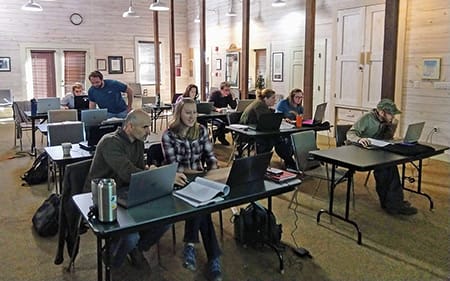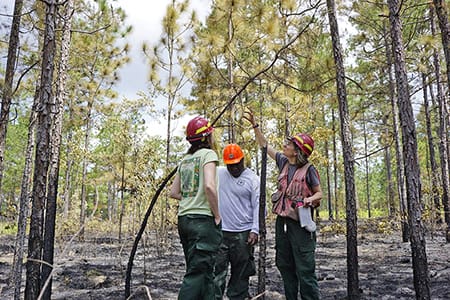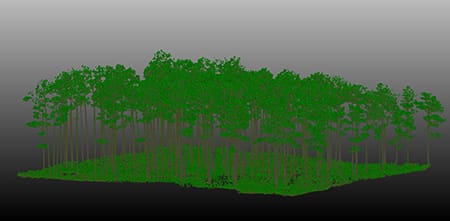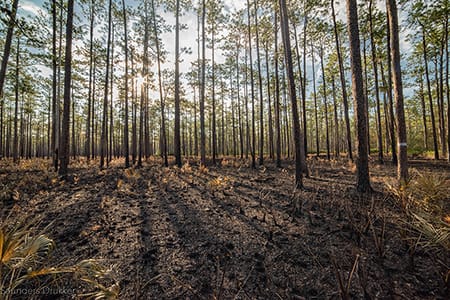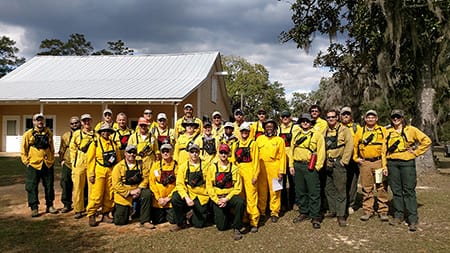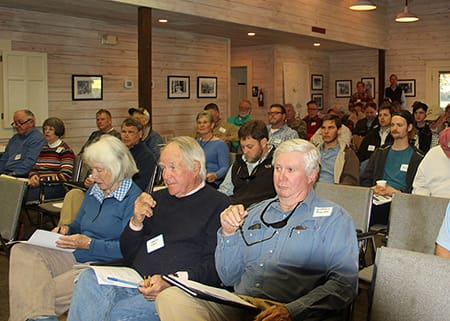Saving the Rare Plants of the Longleaf Pine Ecosystem
The recent book, Saving the Wild South: The Fight for Native Plants on the Brink of Extinction by Georgann Eubanks (2021), highlighted the biodiversity crisis of rare native plants in southern United States. The book focused on a limited number of federally endangered species and discussed the threats faced by the species, and the individuals working to save them.
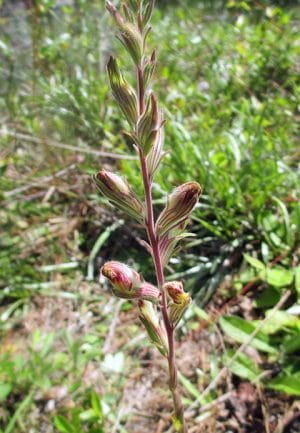
Schwalbea americana in flower at outplant site in the Florida panhandle.
My wife Donna Streng and I are cited in the bibliography for the chapter on Schwalbea americana (American Chaffseed). We are among the leaders in the decades long fight to save this species. Among other accomplishments, along with collaborators, we (1) demonstrated the need for frequent fire in the management of this plant and the population crashes that occur with even slight reductions in fire frequency (Glitzenstein et al. 2001), (2) devised an uncomplicated propagation method that allows easy greenhouse production of numerous plants for out-planting (Gustafson et al. 2017), (3) were the first to publish on a successfully outplanted new population (Glitzenstein et al. 2016), and (4) have planted out several apparently successful populations in three southern states including Alabama, Florida, and South Carolina. In addition, I discovered the largest known population, in South Carolina in 2008, and along with two others, rediscovered the species in Alabama shortly thereafter. I also reviewed for the U.S. Fish and Wildlife Service (USFWS) the most recent version of the five-year review for recovery of the species (2019). Presently, Donna and I are working on a manuscript pertaining to indicator species and plant associations useful for surveying and outplanting Schwalbea.
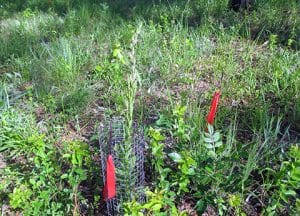
Schwalbea americana (with red flagging) at outplant site in Alabama.
Schwalbea americana occurs in a few remnant populations in eight states including Louisiana, Florida, Georgia, Alabama, South Carolina, North Carolina, New Jersey, and Massachusetts. The species was believed extirpated in Louisiana, Alabama, and Massachusetts, but was rediscovered within the last two decades. Like many other species of longleaf pine groundcover, the primary threat is fire exclusion or insufficiently frequent fire. Some observations suggest the recent shift from traditional dormant season burning to burning early in the growing season, e.g. in April shortly after emergence in the spring, may be negatively impacting the species, although this seems not always to be the case. Additional research is needed on season of burn, soil moisture effects, and effects of fire intensity variables. The species may be able to tolerate and even benefit from some limited amount of soil disturbance, but excessively frequent or intensive soil disturbance will eliminate it. More research is needed to understand impacts of soil disturbance regimes. Donna and I will work with any landowner who wishes to manage or restore Schwalbea. Protections of the federal Endangered Species Act do not extend to private lands as far as plants are concerned, so landowners can do as they like with federally endangered plants on their property. This can be a positive, as well as a negative for rare plant conservation, since there is more flexibility for management and restoration.
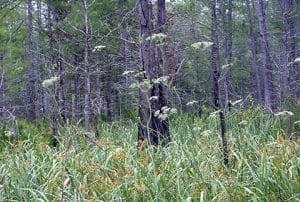
Oxypolis canbyi (tall white flowers) in flower in South Carolina.
In addition to Schwalbea, we have worked to save many other southern rare plant species. One species not discussed in Eubank’s book is Oxypolis canbyi (Canby’s Dropwort), a federally endangered plant of depressional wetlands embedded within longleaf pine savannas and woodlands. We were the first to successfully propagate this species and the first to outplant new populations.
We also helped in restoring and managing a South Carolina population owned by the South Carolina Native Plant Society (SCNPS). When SCNPS acquired the site, the surrounding upland was a dense, low diversity loblolly pine plantation with a history of insufficient fire. SCNPS removed the loblolly, reinitiated a frequent fire regime, and planted longleaf pine, wiregrass, and other native groundcover plants in the uplands. In addition, wetland hardwoods were removed, and dense pond cypress thinned in the wetland itself. This restoration has been spectacularly successful; beginning with a couple of hundred stems, the Oxypolis population now numbers in the tens of thousands, and the planted wiregrass has reproduced and filled in the surrounding upland.
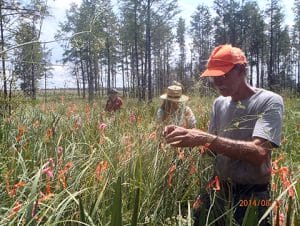
Glitzenstein and volunteers monitor Oxypolis canbyi in South Carolina.
In concluding, we need to acknowledge some essential collaborators: Jason Ayers, April Punsalan and Jim Bates, with the U.S. Fish and Wildlife Service; Michael Jenkins with state of Florida’s rare plant conservation program; Craig Iversen, and Liz Langston with Blackwater River State Forest; Guy Anglin, landowner and retired botanist/ecologist with the US Forest Service and FL Department of Environmental Protection; Eric Soehren with Alabama Department with Conservation and Natural Resources; John Brubaker, a landowner retired from the Medical University of South Carolina; Whitney Costner of Bok Tower Botanical Garden; Grace Howell of Alachua Conservation Land Trust; Danny Gustafson, professor at the Citadel; Sharon Hermann, professor at Auburn University, retired; Sudie Thomas, USDA Natural Resources and Conservation Program; Joe Cockrell, Audubon Society, USFWS retired; Johnny Stowe and Allen Bridgeman of South Carolina Department of Natural Resources; and Seth Hunt and Jason Martin of Westervelt Corp.
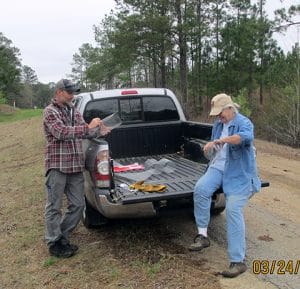
Collaborators Eric Soehren (Alabama Department of Conservation and Natural Resources) and Sharon Hermann (Auburn University, retired) make Schwalbea protection “cages” at the Alabama outplant site.
Literature Cited
Eubanks, G. 2021. Saving the Wild South: The Fight for Native Plants on the Brink of Extinction. University of North Carolina Press, Chapel Hill.
Glitzenstein, J. S., D. R. Streng, D. D. Wade, J. Brubaker. 2001. Starting new populations of longleaf pine ground-layer plants in the outer coastal plain of South Carolina. Natural Areas Journal 21:89-110.
Glitzenstein, J.S., D. J. Gustafson, J.P. Stowe, D. R. Streng, D. A. Bridgman, Jr., J. M. Fill, and J. T. Ayers. 2016. Starting a new population of Schwalbea americana on a longleaf pine restoration site in South Carolina. Castanea 81(4): 302-313.
Gustafson, D.J., S. E. Woodyard Jr., J. Marquez, W. D. Rhoad V., J. S. Glitzenstein, and J. M. Gramling. Greenhouse propagation of the endangered hemiparasite Schwalbea americana (American Chaffseed): experimentation and botanical observations. 2017. Native Plants Journal 18(1): 51-59
[USFWS] U.S. Fish and Wildlife Service. 2017. American Chaffseed (Schwalbea americana) 5-Year Review: Summary and Evaluation. 2019. Southeast Region, South Carolina Ecological Services Field Office, Charleston, SC. Review conducted by A. Punsalan.








